Strategic Management Accounting Techniques for ComfortDelGro in Sharing Economy
VerifiedAdded on 2023/06/03
|18
|4633
|260
AI Summary
This article discusses the strategic management accounting techniques used by ComfortDelGro in the sharing economy. It covers SWOT analysis, incentive compensation techniques, KPI and balance score card approach, and customer profitability analysis. The article explains how these techniques help the company gain a competitive advantage. The subject is strategic management accounting and accounting tools. The course code and college/university are not mentioned.
Contribute Materials
Your contribution can guide someone’s learning journey. Share your
documents today.
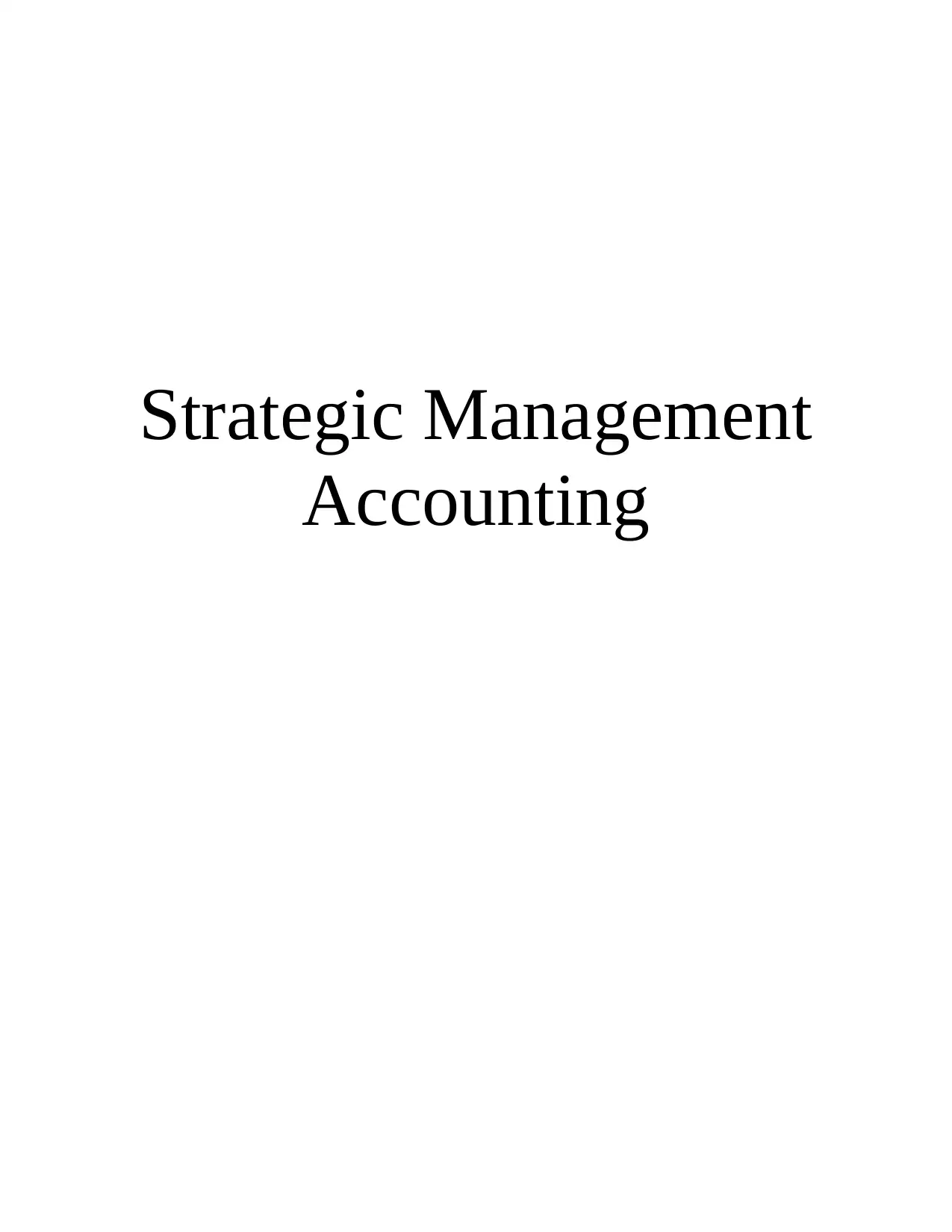
Strategic Management
Accounting
Accounting
Secure Best Marks with AI Grader
Need help grading? Try our AI Grader for instant feedback on your assignments.
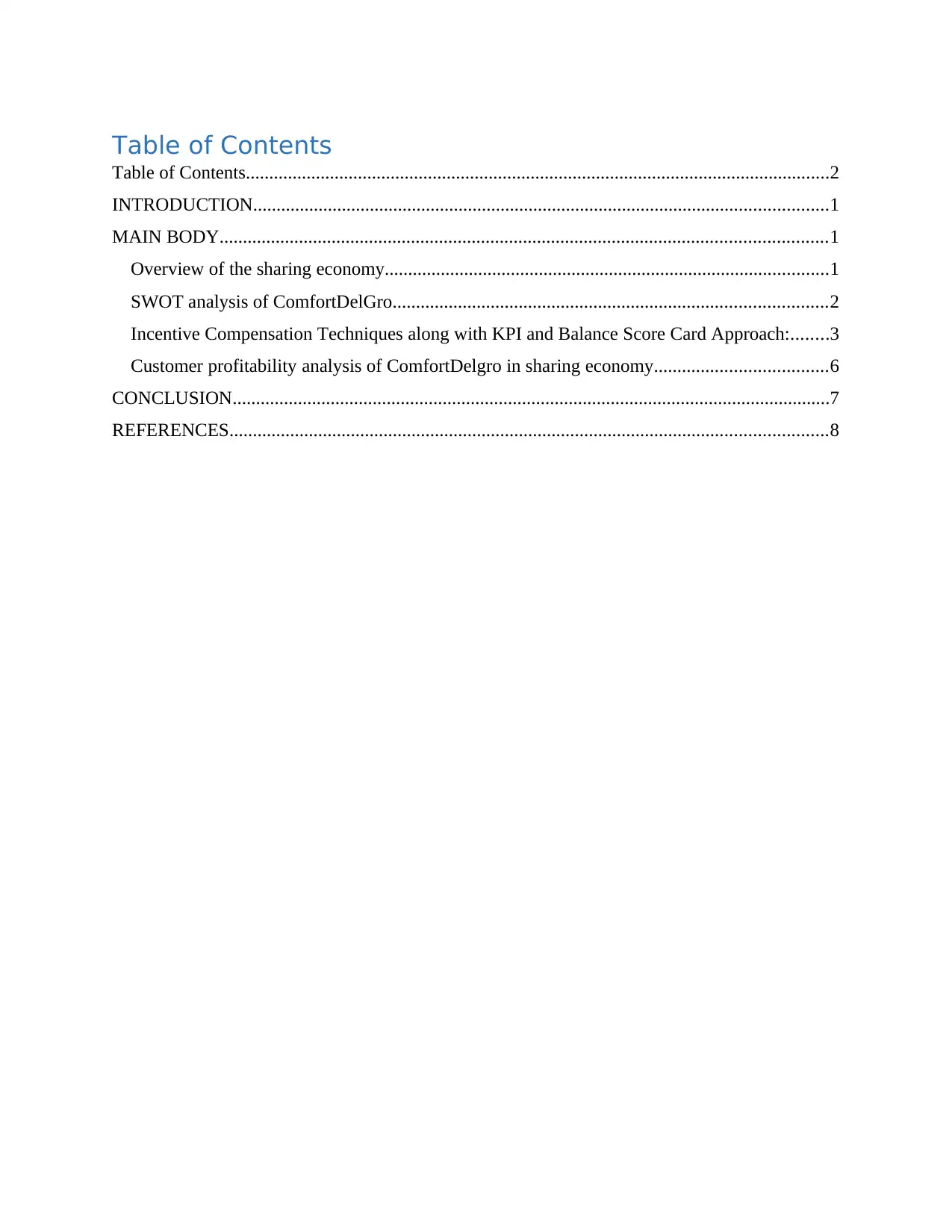
Table of Contents
Table of Contents.............................................................................................................................2
INTRODUCTION...........................................................................................................................1
MAIN BODY..................................................................................................................................1
Overview of the sharing economy...............................................................................................1
SWOT analysis of ComfortDelGro.............................................................................................2
Incentive Compensation Techniques along with KPI and Balance Score Card Approach:........3
Customer profitability analysis of ComfortDelgro in sharing economy.....................................6
CONCLUSION................................................................................................................................7
REFERENCES................................................................................................................................8
Table of Contents.............................................................................................................................2
INTRODUCTION...........................................................................................................................1
MAIN BODY..................................................................................................................................1
Overview of the sharing economy...............................................................................................1
SWOT analysis of ComfortDelGro.............................................................................................2
Incentive Compensation Techniques along with KPI and Balance Score Card Approach:........3
Customer profitability analysis of ComfortDelgro in sharing economy.....................................6
CONCLUSION................................................................................................................................7
REFERENCES................................................................................................................................8

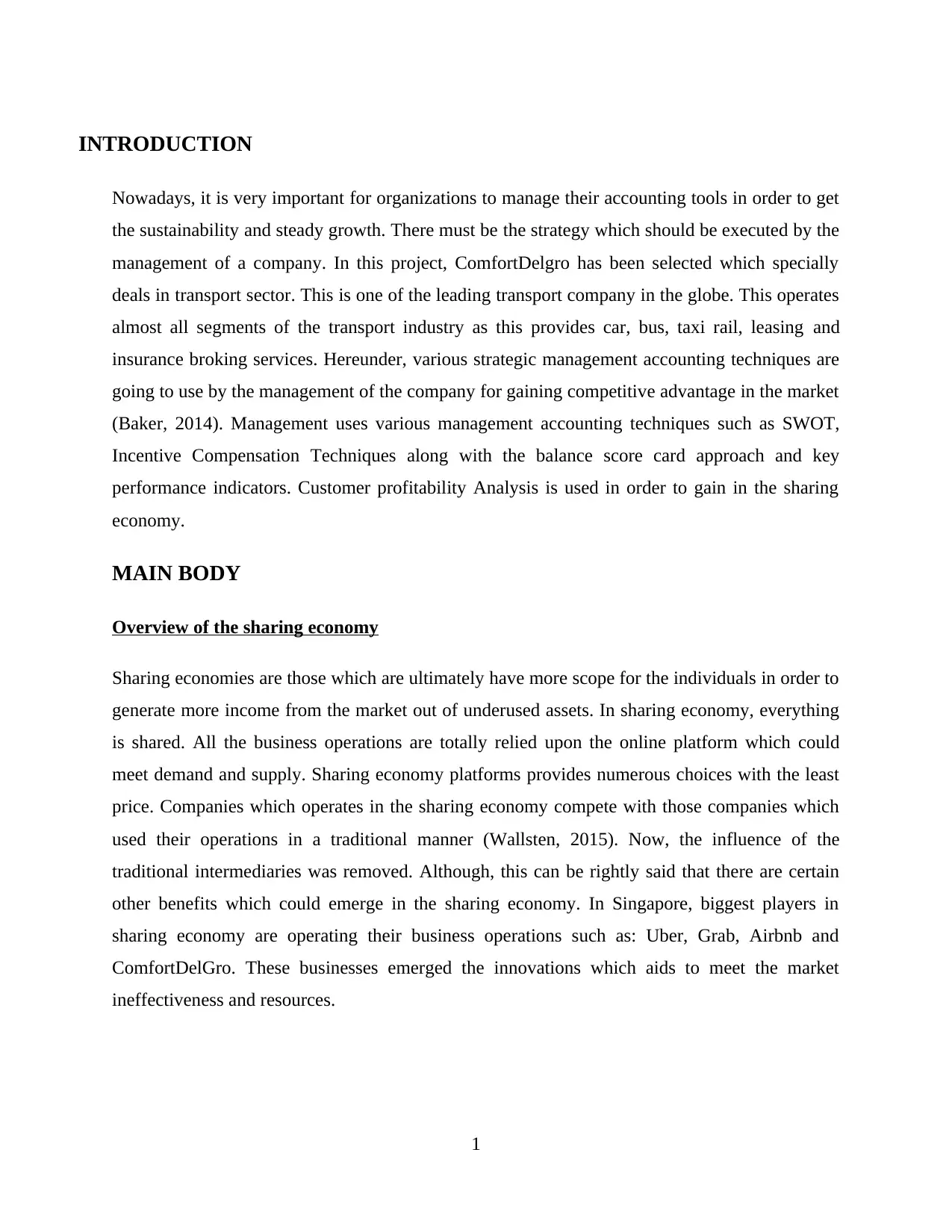
INTRODUCTION
Nowadays, it is very important for organizations to manage their accounting tools in order to get
the sustainability and steady growth. There must be the strategy which should be executed by the
management of a company. In this project, ComfortDelgro has been selected which specially
deals in transport sector. This is one of the leading transport company in the globe. This operates
almost all segments of the transport industry as this provides car, bus, taxi rail, leasing and
insurance broking services. Hereunder, various strategic management accounting techniques are
going to use by the management of the company for gaining competitive advantage in the market
(Baker, 2014). Management uses various management accounting techniques such as SWOT,
Incentive Compensation Techniques along with the balance score card approach and key
performance indicators. Customer profitability Analysis is used in order to gain in the sharing
economy.
MAIN BODY
Overview of the sharing economy
Sharing economies are those which are ultimately have more scope for the individuals in order to
generate more income from the market out of underused assets. In sharing economy, everything
is shared. All the business operations are totally relied upon the online platform which could
meet demand and supply. Sharing economy platforms provides numerous choices with the least
price. Companies which operates in the sharing economy compete with those companies which
used their operations in a traditional manner (Wallsten, 2015). Now, the influence of the
traditional intermediaries was removed. Although, this can be rightly said that there are certain
other benefits which could emerge in the sharing economy. In Singapore, biggest players in
sharing economy are operating their business operations such as: Uber, Grab, Airbnb and
ComfortDelGro. These businesses emerged the innovations which aids to meet the market
ineffectiveness and resources.
1
Nowadays, it is very important for organizations to manage their accounting tools in order to get
the sustainability and steady growth. There must be the strategy which should be executed by the
management of a company. In this project, ComfortDelgro has been selected which specially
deals in transport sector. This is one of the leading transport company in the globe. This operates
almost all segments of the transport industry as this provides car, bus, taxi rail, leasing and
insurance broking services. Hereunder, various strategic management accounting techniques are
going to use by the management of the company for gaining competitive advantage in the market
(Baker, 2014). Management uses various management accounting techniques such as SWOT,
Incentive Compensation Techniques along with the balance score card approach and key
performance indicators. Customer profitability Analysis is used in order to gain in the sharing
economy.
MAIN BODY
Overview of the sharing economy
Sharing economies are those which are ultimately have more scope for the individuals in order to
generate more income from the market out of underused assets. In sharing economy, everything
is shared. All the business operations are totally relied upon the online platform which could
meet demand and supply. Sharing economy platforms provides numerous choices with the least
price. Companies which operates in the sharing economy compete with those companies which
used their operations in a traditional manner (Wallsten, 2015). Now, the influence of the
traditional intermediaries was removed. Although, this can be rightly said that there are certain
other benefits which could emerge in the sharing economy. In Singapore, biggest players in
sharing economy are operating their business operations such as: Uber, Grab, Airbnb and
ComfortDelGro. These businesses emerged the innovations which aids to meet the market
ineffectiveness and resources.
1
Secure Best Marks with AI Grader
Need help grading? Try our AI Grader for instant feedback on your assignments.
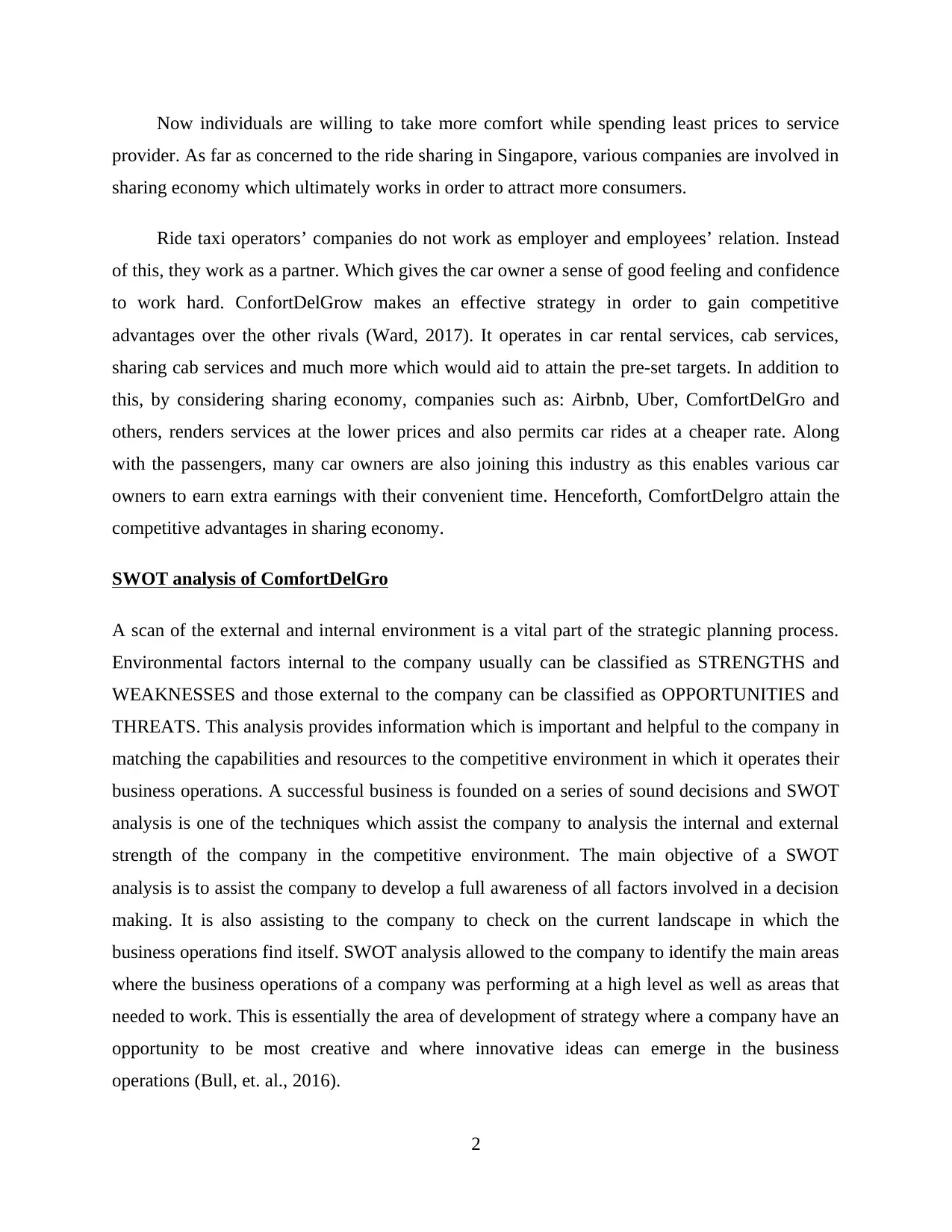
Now individuals are willing to take more comfort while spending least prices to service
provider. As far as concerned to the ride sharing in Singapore, various companies are involved in
sharing economy which ultimately works in order to attract more consumers.
Ride taxi operators’ companies do not work as employer and employees’ relation. Instead
of this, they work as a partner. Which gives the car owner a sense of good feeling and confidence
to work hard. ConfortDelGrow makes an effective strategy in order to gain competitive
advantages over the other rivals (Ward, 2017). It operates in car rental services, cab services,
sharing cab services and much more which would aid to attain the pre-set targets. In addition to
this, by considering sharing economy, companies such as: Airbnb, Uber, ComfortDelGro and
others, renders services at the lower prices and also permits car rides at a cheaper rate. Along
with the passengers, many car owners are also joining this industry as this enables various car
owners to earn extra earnings with their convenient time. Henceforth, ComfortDelgro attain the
competitive advantages in sharing economy.
SWOT analysis of ComfortDelGro
A scan of the external and internal environment is a vital part of the strategic planning process.
Environmental factors internal to the company usually can be classified as STRENGTHS and
WEAKNESSES and those external to the company can be classified as OPPORTUNITIES and
THREATS. This analysis provides information which is important and helpful to the company in
matching the capabilities and resources to the competitive environment in which it operates their
business operations. A successful business is founded on a series of sound decisions and SWOT
analysis is one of the techniques which assist the company to analysis the internal and external
strength of the company in the competitive environment. The main objective of a SWOT
analysis is to assist the company to develop a full awareness of all factors involved in a decision
making. It is also assisting to the company to check on the current landscape in which the
business operations find itself. SWOT analysis allowed to the company to identify the main areas
where the business operations of a company was performing at a high level as well as areas that
needed to work. This is essentially the area of development of strategy where a company have an
opportunity to be most creative and where innovative ideas can emerge in the business
operations (Bull, et. al., 2016).
2
provider. As far as concerned to the ride sharing in Singapore, various companies are involved in
sharing economy which ultimately works in order to attract more consumers.
Ride taxi operators’ companies do not work as employer and employees’ relation. Instead
of this, they work as a partner. Which gives the car owner a sense of good feeling and confidence
to work hard. ConfortDelGrow makes an effective strategy in order to gain competitive
advantages over the other rivals (Ward, 2017). It operates in car rental services, cab services,
sharing cab services and much more which would aid to attain the pre-set targets. In addition to
this, by considering sharing economy, companies such as: Airbnb, Uber, ComfortDelGro and
others, renders services at the lower prices and also permits car rides at a cheaper rate. Along
with the passengers, many car owners are also joining this industry as this enables various car
owners to earn extra earnings with their convenient time. Henceforth, ComfortDelgro attain the
competitive advantages in sharing economy.
SWOT analysis of ComfortDelGro
A scan of the external and internal environment is a vital part of the strategic planning process.
Environmental factors internal to the company usually can be classified as STRENGTHS and
WEAKNESSES and those external to the company can be classified as OPPORTUNITIES and
THREATS. This analysis provides information which is important and helpful to the company in
matching the capabilities and resources to the competitive environment in which it operates their
business operations. A successful business is founded on a series of sound decisions and SWOT
analysis is one of the techniques which assist the company to analysis the internal and external
strength of the company in the competitive environment. The main objective of a SWOT
analysis is to assist the company to develop a full awareness of all factors involved in a decision
making. It is also assisting to the company to check on the current landscape in which the
business operations find itself. SWOT analysis allowed to the company to identify the main areas
where the business operations of a company was performing at a high level as well as areas that
needed to work. This is essentially the area of development of strategy where a company have an
opportunity to be most creative and where innovative ideas can emerge in the business
operations (Bull, et. al., 2016).
2
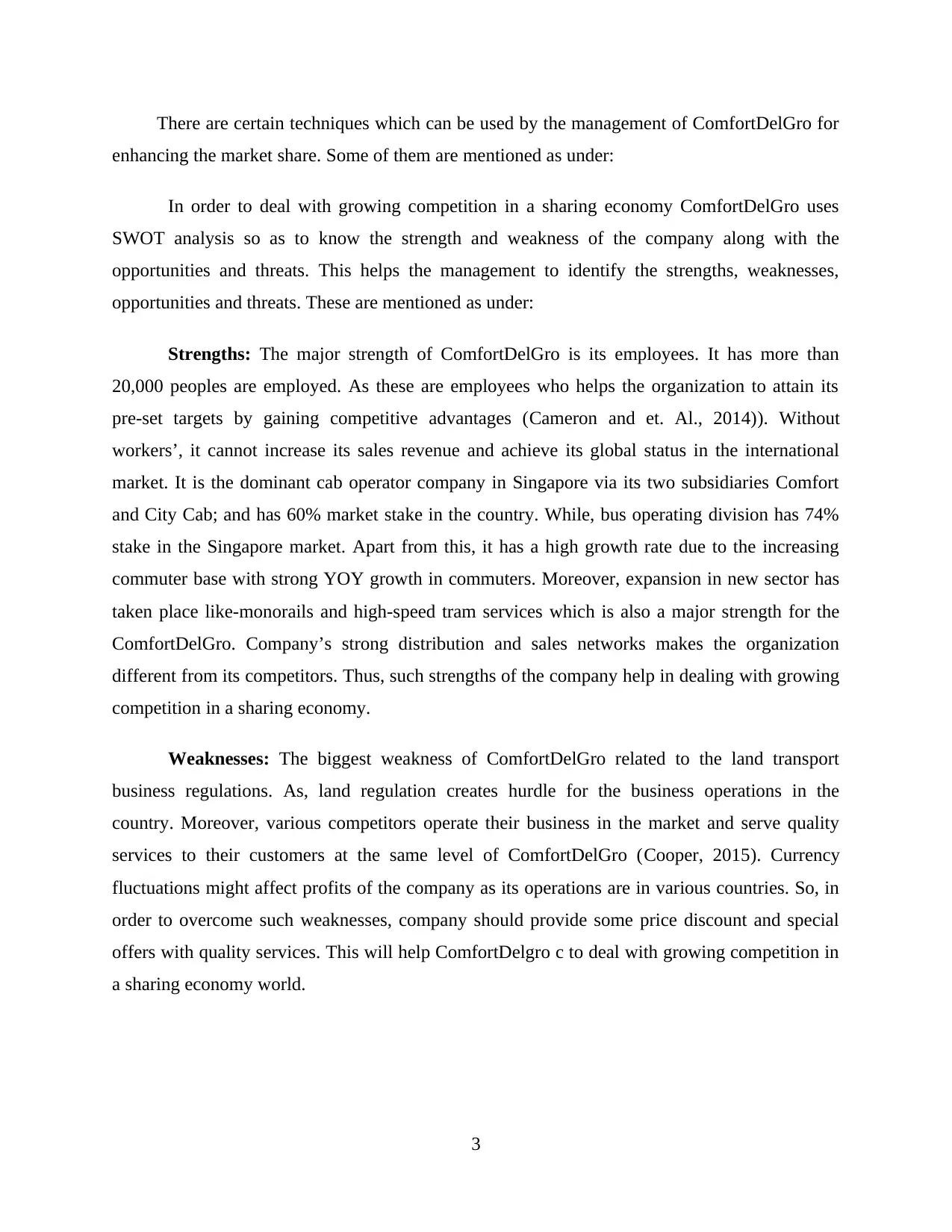
There are certain techniques which can be used by the management of ComfortDelGro for
enhancing the market share. Some of them are mentioned as under:
In order to deal with growing competition in a sharing economy ComfortDelGro uses
SWOT analysis so as to know the strength and weakness of the company along with the
opportunities and threats. This helps the management to identify the strengths, weaknesses,
opportunities and threats. These are mentioned as under:
Strengths: The major strength of ComfortDelGro is its employees. It has more than
20,000 peoples are employed. As these are employees who helps the organization to attain its
pre-set targets by gaining competitive advantages (Cameron and et. Al., 2014)). Without
workers’, it cannot increase its sales revenue and achieve its global status in the international
market. It is the dominant cab operator company in Singapore via its two subsidiaries Comfort
and City Cab; and has 60% market stake in the country. While, bus operating division has 74%
stake in the Singapore market. Apart from this, it has a high growth rate due to the increasing
commuter base with strong YOY growth in commuters. Moreover, expansion in new sector has
taken place like-monorails and high-speed tram services which is also a major strength for the
ComfortDelGro. Company’s strong distribution and sales networks makes the organization
different from its competitors. Thus, such strengths of the company help in dealing with growing
competition in a sharing economy.
Weaknesses: The biggest weakness of ComfortDelGro related to the land transport
business regulations. As, land regulation creates hurdle for the business operations in the
country. Moreover, various competitors operate their business in the market and serve quality
services to their customers at the same level of ComfortDelGro (Cooper, 2015). Currency
fluctuations might affect profits of the company as its operations are in various countries. So, in
order to overcome such weaknesses, company should provide some price discount and special
offers with quality services. This will help ComfortDelgro c to deal with growing competition in
a sharing economy world.
3
enhancing the market share. Some of them are mentioned as under:
In order to deal with growing competition in a sharing economy ComfortDelGro uses
SWOT analysis so as to know the strength and weakness of the company along with the
opportunities and threats. This helps the management to identify the strengths, weaknesses,
opportunities and threats. These are mentioned as under:
Strengths: The major strength of ComfortDelGro is its employees. It has more than
20,000 peoples are employed. As these are employees who helps the organization to attain its
pre-set targets by gaining competitive advantages (Cameron and et. Al., 2014)). Without
workers’, it cannot increase its sales revenue and achieve its global status in the international
market. It is the dominant cab operator company in Singapore via its two subsidiaries Comfort
and City Cab; and has 60% market stake in the country. While, bus operating division has 74%
stake in the Singapore market. Apart from this, it has a high growth rate due to the increasing
commuter base with strong YOY growth in commuters. Moreover, expansion in new sector has
taken place like-monorails and high-speed tram services which is also a major strength for the
ComfortDelGro. Company’s strong distribution and sales networks makes the organization
different from its competitors. Thus, such strengths of the company help in dealing with growing
competition in a sharing economy.
Weaknesses: The biggest weakness of ComfortDelGro related to the land transport
business regulations. As, land regulation creates hurdle for the business operations in the
country. Moreover, various competitors operate their business in the market and serve quality
services to their customers at the same level of ComfortDelGro (Cooper, 2015). Currency
fluctuations might affect profits of the company as its operations are in various countries. So, in
order to overcome such weaknesses, company should provide some price discount and special
offers with quality services. This will help ComfortDelgro c to deal with growing competition in
a sharing economy world.
3
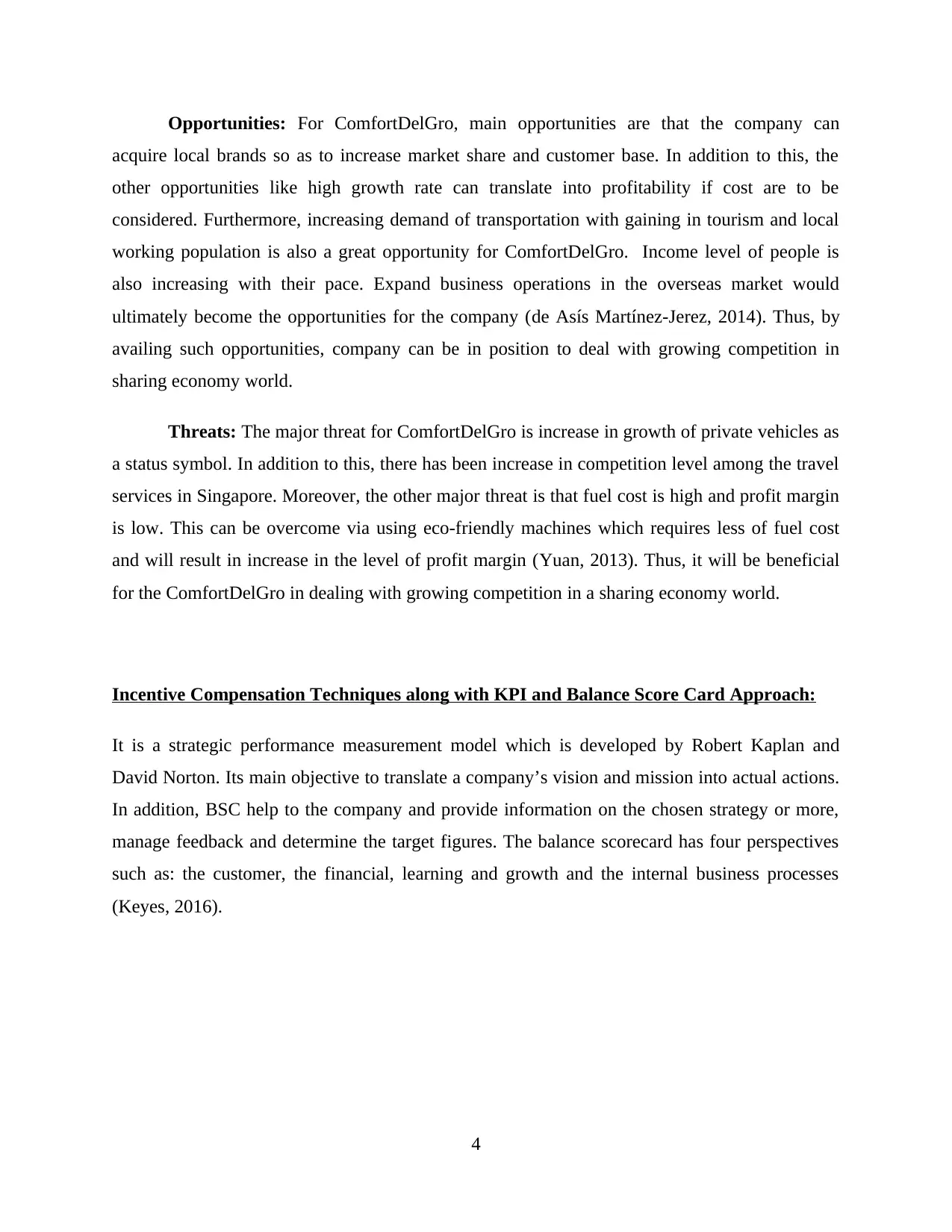
Opportunities: For ComfortDelGro, main opportunities are that the company can
acquire local brands so as to increase market share and customer base. In addition to this, the
other opportunities like high growth rate can translate into profitability if cost are to be
considered. Furthermore, increasing demand of transportation with gaining in tourism and local
working population is also a great opportunity for ComfortDelGro. Income level of people is
also increasing with their pace. Expand business operations in the overseas market would
ultimately become the opportunities for the company (de Asís Martínez-Jerez, 2014). Thus, by
availing such opportunities, company can be in position to deal with growing competition in
sharing economy world.
Threats: The major threat for ComfortDelGro is increase in growth of private vehicles as
a status symbol. In addition to this, there has been increase in competition level among the travel
services in Singapore. Moreover, the other major threat is that fuel cost is high and profit margin
is low. This can be overcome via using eco-friendly machines which requires less of fuel cost
and will result in increase in the level of profit margin (Yuan, 2013). Thus, it will be beneficial
for the ComfortDelGro in dealing with growing competition in a sharing economy world.
Incentive Compensation Techniques along with KPI and Balance Score Card Approach:
It is a strategic performance measurement model which is developed by Robert Kaplan and
David Norton. Its main objective to translate a company’s vision and mission into actual actions.
In addition, BSC help to the company and provide information on the chosen strategy or more,
manage feedback and determine the target figures. The balance scorecard has four perspectives
such as: the customer, the financial, learning and growth and the internal business processes
(Keyes, 2016).
4
acquire local brands so as to increase market share and customer base. In addition to this, the
other opportunities like high growth rate can translate into profitability if cost are to be
considered. Furthermore, increasing demand of transportation with gaining in tourism and local
working population is also a great opportunity for ComfortDelGro. Income level of people is
also increasing with their pace. Expand business operations in the overseas market would
ultimately become the opportunities for the company (de Asís Martínez-Jerez, 2014). Thus, by
availing such opportunities, company can be in position to deal with growing competition in
sharing economy world.
Threats: The major threat for ComfortDelGro is increase in growth of private vehicles as
a status symbol. In addition to this, there has been increase in competition level among the travel
services in Singapore. Moreover, the other major threat is that fuel cost is high and profit margin
is low. This can be overcome via using eco-friendly machines which requires less of fuel cost
and will result in increase in the level of profit margin (Yuan, 2013). Thus, it will be beneficial
for the ComfortDelGro in dealing with growing competition in a sharing economy world.
Incentive Compensation Techniques along with KPI and Balance Score Card Approach:
It is a strategic performance measurement model which is developed by Robert Kaplan and
David Norton. Its main objective to translate a company’s vision and mission into actual actions.
In addition, BSC help to the company and provide information on the chosen strategy or more,
manage feedback and determine the target figures. The balance scorecard has four perspectives
such as: the customer, the financial, learning and growth and the internal business processes
(Keyes, 2016).
4
Paraphrase This Document
Need a fresh take? Get an instant paraphrase of this document with our AI Paraphraser
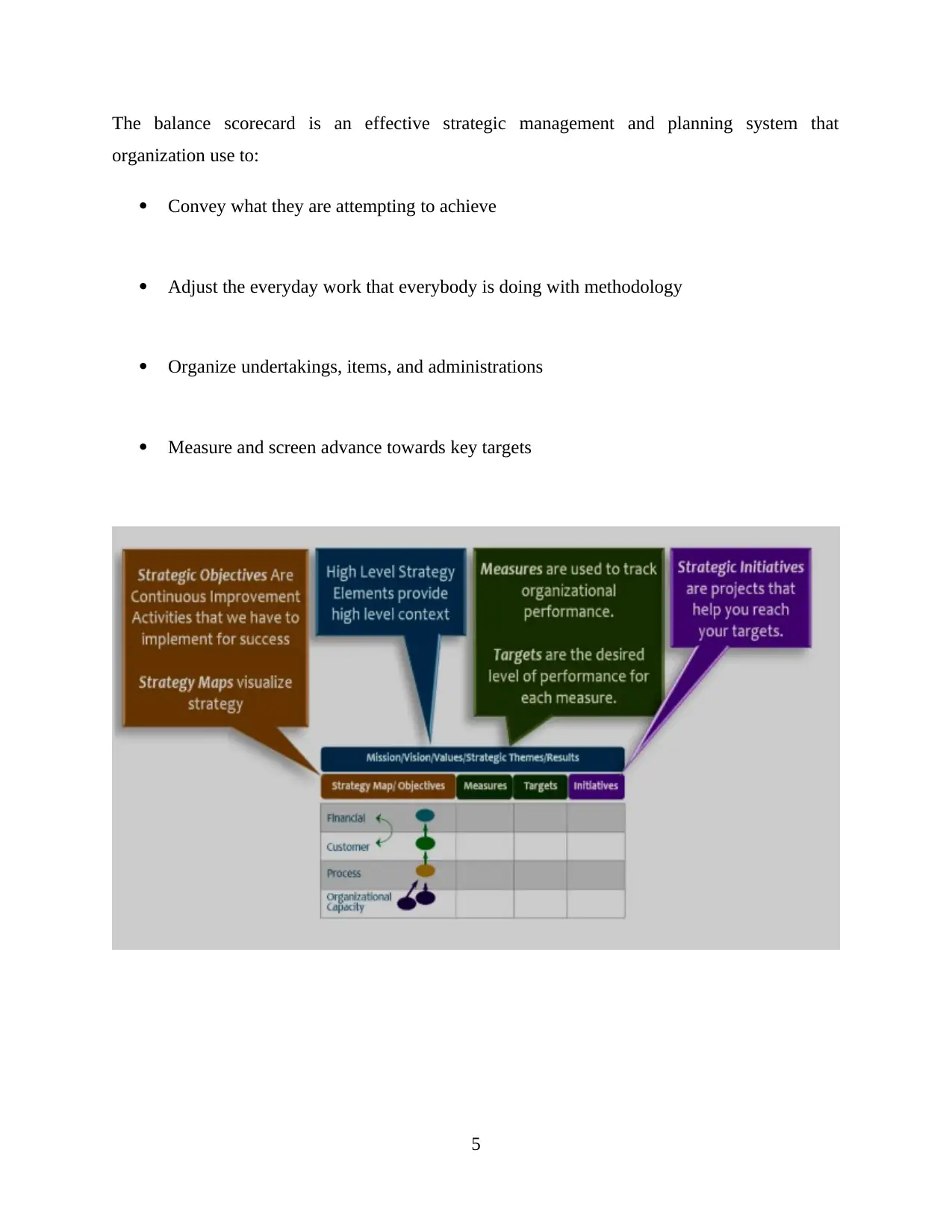
The balance scorecard is an effective strategic management and planning system that
organization use to:
Convey what they are attempting to achieve
Adjust the everyday work that everybody is doing with methodology
Organize undertakings, items, and administrations
Measure and screen advance towards key targets
5
organization use to:
Convey what they are attempting to achieve
Adjust the everyday work that everybody is doing with methodology
Organize undertakings, items, and administrations
Measure and screen advance towards key targets
5
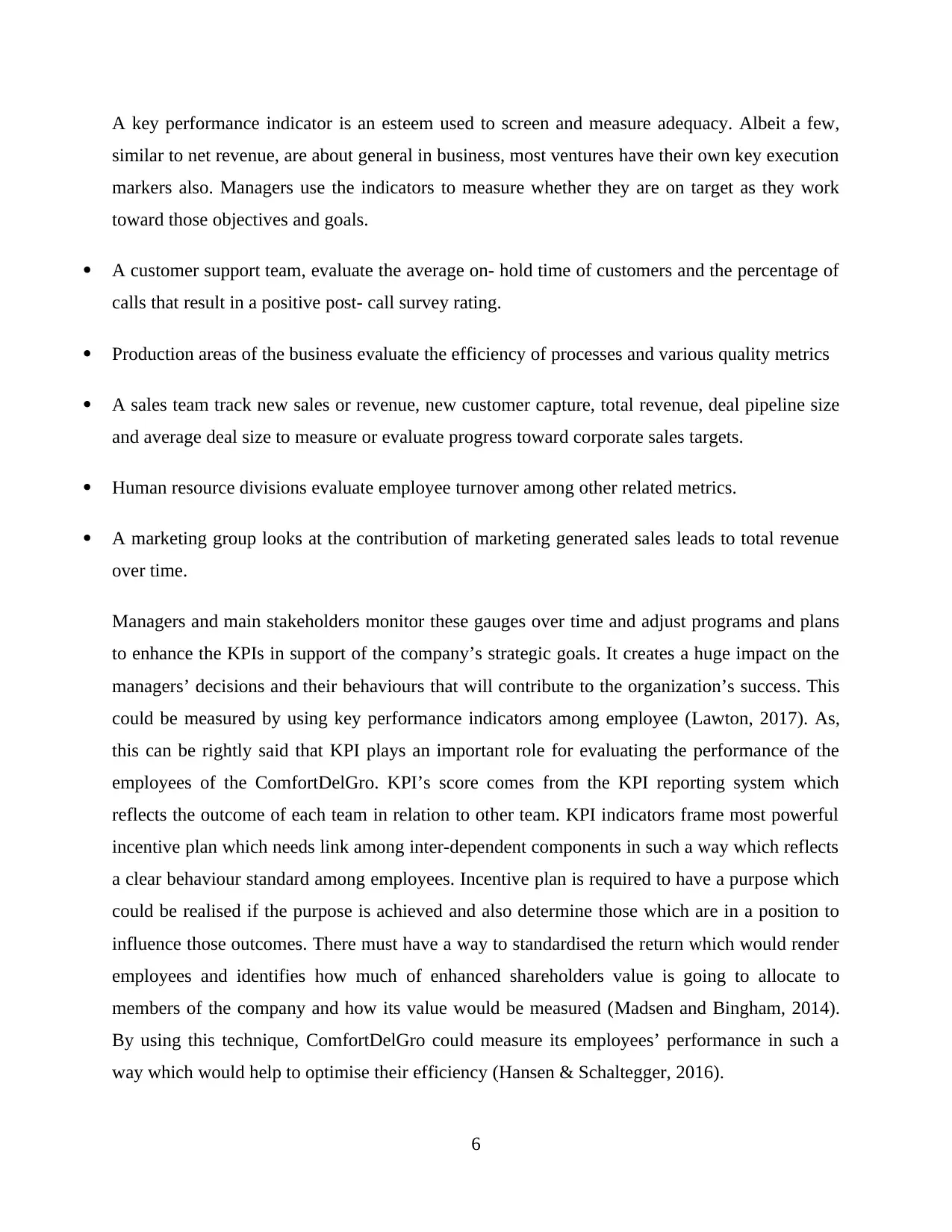
A key performance indicator is an esteem used to screen and measure adequacy. Albeit a few,
similar to net revenue, are about general in business, most ventures have their own key execution
markers also. Managers use the indicators to measure whether they are on target as they work
toward those objectives and goals.
A customer support team, evaluate the average on- hold time of customers and the percentage of
calls that result in a positive post- call survey rating.
Production areas of the business evaluate the efficiency of processes and various quality metrics
A sales team track new sales or revenue, new customer capture, total revenue, deal pipeline size
and average deal size to measure or evaluate progress toward corporate sales targets.
Human resource divisions evaluate employee turnover among other related metrics.
A marketing group looks at the contribution of marketing generated sales leads to total revenue
over time.
Managers and main stakeholders monitor these gauges over time and adjust programs and plans
to enhance the KPIs in support of the company’s strategic goals. It creates a huge impact on the
managers’ decisions and their behaviours that will contribute to the organization’s success. This
could be measured by using key performance indicators among employee (Lawton, 2017). As,
this can be rightly said that KPI plays an important role for evaluating the performance of the
employees of the ComfortDelGro. KPI’s score comes from the KPI reporting system which
reflects the outcome of each team in relation to other team. KPI indicators frame most powerful
incentive plan which needs link among inter-dependent components in such a way which reflects
a clear behaviour standard among employees. Incentive plan is required to have a purpose which
could be realised if the purpose is achieved and also determine those which are in a position to
influence those outcomes. There must have a way to standardised the return which would render
employees and identifies how much of enhanced shareholders value is going to allocate to
members of the company and how its value would be measured (Madsen and Bingham, 2014).
By using this technique, ComfortDelGro could measure its employees’ performance in such a
way which would help to optimise their efficiency (Hansen & Schaltegger, 2016).
6
similar to net revenue, are about general in business, most ventures have their own key execution
markers also. Managers use the indicators to measure whether they are on target as they work
toward those objectives and goals.
A customer support team, evaluate the average on- hold time of customers and the percentage of
calls that result in a positive post- call survey rating.
Production areas of the business evaluate the efficiency of processes and various quality metrics
A sales team track new sales or revenue, new customer capture, total revenue, deal pipeline size
and average deal size to measure or evaluate progress toward corporate sales targets.
Human resource divisions evaluate employee turnover among other related metrics.
A marketing group looks at the contribution of marketing generated sales leads to total revenue
over time.
Managers and main stakeholders monitor these gauges over time and adjust programs and plans
to enhance the KPIs in support of the company’s strategic goals. It creates a huge impact on the
managers’ decisions and their behaviours that will contribute to the organization’s success. This
could be measured by using key performance indicators among employee (Lawton, 2017). As,
this can be rightly said that KPI plays an important role for evaluating the performance of the
employees of the ComfortDelGro. KPI’s score comes from the KPI reporting system which
reflects the outcome of each team in relation to other team. KPI indicators frame most powerful
incentive plan which needs link among inter-dependent components in such a way which reflects
a clear behaviour standard among employees. Incentive plan is required to have a purpose which
could be realised if the purpose is achieved and also determine those which are in a position to
influence those outcomes. There must have a way to standardised the return which would render
employees and identifies how much of enhanced shareholders value is going to allocate to
members of the company and how its value would be measured (Madsen and Bingham, 2014).
By using this technique, ComfortDelGro could measure its employees’ performance in such a
way which would help to optimise their efficiency (Hansen & Schaltegger, 2016).
6
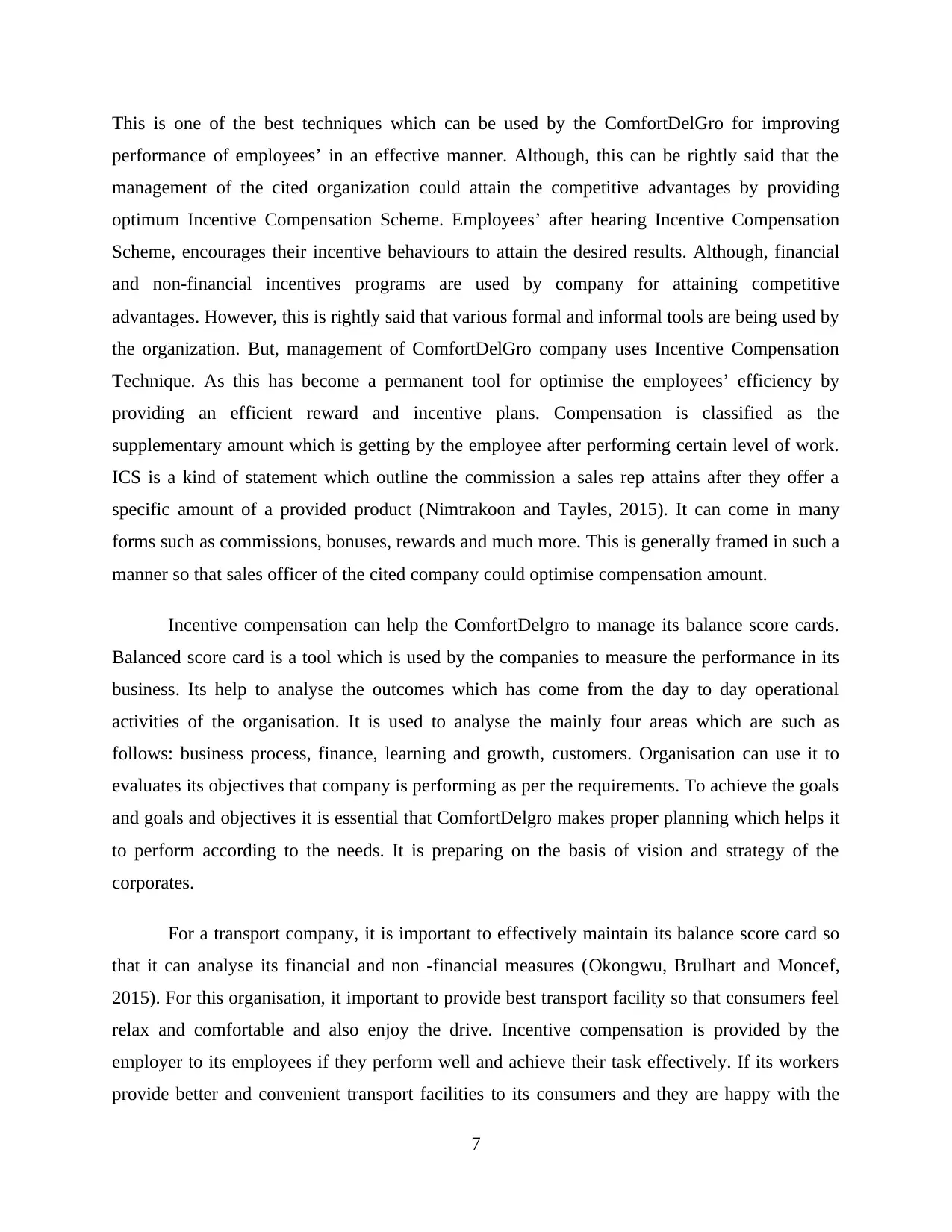
This is one of the best techniques which can be used by the ComfortDelGro for improving
performance of employees’ in an effective manner. Although, this can be rightly said that the
management of the cited organization could attain the competitive advantages by providing
optimum Incentive Compensation Scheme. Employees’ after hearing Incentive Compensation
Scheme, encourages their incentive behaviours to attain the desired results. Although, financial
and non-financial incentives programs are used by company for attaining competitive
advantages. However, this is rightly said that various formal and informal tools are being used by
the organization. But, management of ComfortDelGro company uses Incentive Compensation
Technique. As this has become a permanent tool for optimise the employees’ efficiency by
providing an efficient reward and incentive plans. Compensation is classified as the
supplementary amount which is getting by the employee after performing certain level of work.
ICS is a kind of statement which outline the commission a sales rep attains after they offer a
specific amount of a provided product (Nimtrakoon and Tayles, 2015). It can come in many
forms such as commissions, bonuses, rewards and much more. This is generally framed in such a
manner so that sales officer of the cited company could optimise compensation amount.
Incentive compensation can help the ComfortDelgro to manage its balance score cards.
Balanced score card is a tool which is used by the companies to measure the performance in its
business. Its help to analyse the outcomes which has come from the day to day operational
activities of the organisation. It is used to analyse the mainly four areas which are such as
follows: business process, finance, learning and growth, customers. Organisation can use it to
evaluates its objectives that company is performing as per the requirements. To achieve the goals
and goals and objectives it is essential that ComfortDelgro makes proper planning which helps it
to perform according to the needs. It is preparing on the basis of vision and strategy of the
corporates.
For a transport company, it is important to effectively maintain its balance score card so
that it can analyse its financial and non -financial measures (Okongwu, Brulhart and Moncef,
2015). For this organisation, it important to provide best transport facility so that consumers feel
relax and comfortable and also enjoy the drive. Incentive compensation is provided by the
employer to its employees if they perform well and achieve their task effectively. If its workers
provide better and convenient transport facilities to its consumers and they are happy with the
7
performance of employees’ in an effective manner. Although, this can be rightly said that the
management of the cited organization could attain the competitive advantages by providing
optimum Incentive Compensation Scheme. Employees’ after hearing Incentive Compensation
Scheme, encourages their incentive behaviours to attain the desired results. Although, financial
and non-financial incentives programs are used by company for attaining competitive
advantages. However, this is rightly said that various formal and informal tools are being used by
the organization. But, management of ComfortDelGro company uses Incentive Compensation
Technique. As this has become a permanent tool for optimise the employees’ efficiency by
providing an efficient reward and incentive plans. Compensation is classified as the
supplementary amount which is getting by the employee after performing certain level of work.
ICS is a kind of statement which outline the commission a sales rep attains after they offer a
specific amount of a provided product (Nimtrakoon and Tayles, 2015). It can come in many
forms such as commissions, bonuses, rewards and much more. This is generally framed in such a
manner so that sales officer of the cited company could optimise compensation amount.
Incentive compensation can help the ComfortDelgro to manage its balance score cards.
Balanced score card is a tool which is used by the companies to measure the performance in its
business. Its help to analyse the outcomes which has come from the day to day operational
activities of the organisation. It is used to analyse the mainly four areas which are such as
follows: business process, finance, learning and growth, customers. Organisation can use it to
evaluates its objectives that company is performing as per the requirements. To achieve the goals
and goals and objectives it is essential that ComfortDelgro makes proper planning which helps it
to perform according to the needs. It is preparing on the basis of vision and strategy of the
corporates.
For a transport company, it is important to effectively maintain its balance score card so
that it can analyse its financial and non -financial measures (Okongwu, Brulhart and Moncef,
2015). For this organisation, it important to provide best transport facility so that consumers feel
relax and comfortable and also enjoy the drive. Incentive compensation is provided by the
employer to its employees if they perform well and achieve their task effectively. If its workers
provide better and convenient transport facilities to its consumers and they are happy with the
7
Secure Best Marks with AI Grader
Need help grading? Try our AI Grader for instant feedback on your assignments.
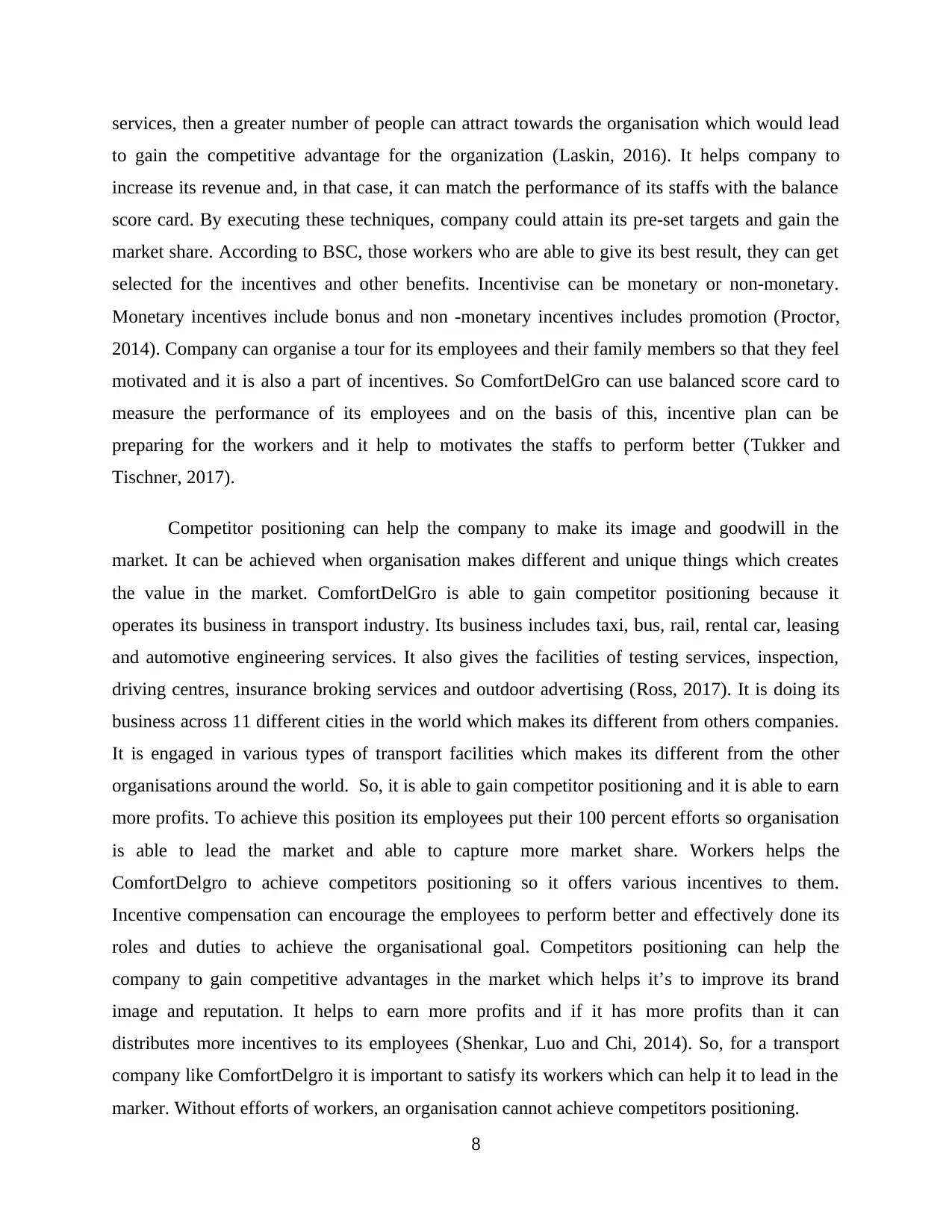
services, then a greater number of people can attract towards the organisation which would lead
to gain the competitive advantage for the organization (Laskin, 2016). It helps company to
increase its revenue and, in that case, it can match the performance of its staffs with the balance
score card. By executing these techniques, company could attain its pre-set targets and gain the
market share. According to BSC, those workers who are able to give its best result, they can get
selected for the incentives and other benefits. Incentivise can be monetary or non-monetary.
Monetary incentives include bonus and non -monetary incentives includes promotion (Proctor,
2014). Company can organise a tour for its employees and their family members so that they feel
motivated and it is also a part of incentives. So ComfortDelGro can use balanced score card to
measure the performance of its employees and on the basis of this, incentive plan can be
preparing for the workers and it help to motivates the staffs to perform better (Tukker and
Tischner, 2017).
Competitor positioning can help the company to make its image and goodwill in the
market. It can be achieved when organisation makes different and unique things which creates
the value in the market. ComfortDelGro is able to gain competitor positioning because it
operates its business in transport industry. Its business includes taxi, bus, rail, rental car, leasing
and automotive engineering services. It also gives the facilities of testing services, inspection,
driving centres, insurance broking services and outdoor advertising (Ross, 2017). It is doing its
business across 11 different cities in the world which makes its different from others companies.
It is engaged in various types of transport facilities which makes its different from the other
organisations around the world. So, it is able to gain competitor positioning and it is able to earn
more profits. To achieve this position its employees put their 100 percent efforts so organisation
is able to lead the market and able to capture more market share. Workers helps the
ComfortDelgro to achieve competitors positioning so it offers various incentives to them.
Incentive compensation can encourage the employees to perform better and effectively done its
roles and duties to achieve the organisational goal. Competitors positioning can help the
company to gain competitive advantages in the market which helps it’s to improve its brand
image and reputation. It helps to earn more profits and if it has more profits than it can
distributes more incentives to its employees (Shenkar, Luo and Chi, 2014). So, for a transport
company like ComfortDelgro it is important to satisfy its workers which can help it to lead in the
marker. Without efforts of workers, an organisation cannot achieve competitors positioning.
8
to gain the competitive advantage for the organization (Laskin, 2016). It helps company to
increase its revenue and, in that case, it can match the performance of its staffs with the balance
score card. By executing these techniques, company could attain its pre-set targets and gain the
market share. According to BSC, those workers who are able to give its best result, they can get
selected for the incentives and other benefits. Incentivise can be monetary or non-monetary.
Monetary incentives include bonus and non -monetary incentives includes promotion (Proctor,
2014). Company can organise a tour for its employees and their family members so that they feel
motivated and it is also a part of incentives. So ComfortDelGro can use balanced score card to
measure the performance of its employees and on the basis of this, incentive plan can be
preparing for the workers and it help to motivates the staffs to perform better (Tukker and
Tischner, 2017).
Competitor positioning can help the company to make its image and goodwill in the
market. It can be achieved when organisation makes different and unique things which creates
the value in the market. ComfortDelGro is able to gain competitor positioning because it
operates its business in transport industry. Its business includes taxi, bus, rail, rental car, leasing
and automotive engineering services. It also gives the facilities of testing services, inspection,
driving centres, insurance broking services and outdoor advertising (Ross, 2017). It is doing its
business across 11 different cities in the world which makes its different from others companies.
It is engaged in various types of transport facilities which makes its different from the other
organisations around the world. So, it is able to gain competitor positioning and it is able to earn
more profits. To achieve this position its employees put their 100 percent efforts so organisation
is able to lead the market and able to capture more market share. Workers helps the
ComfortDelgro to achieve competitors positioning so it offers various incentives to them.
Incentive compensation can encourage the employees to perform better and effectively done its
roles and duties to achieve the organisational goal. Competitors positioning can help the
company to gain competitive advantages in the market which helps it’s to improve its brand
image and reputation. It helps to earn more profits and if it has more profits than it can
distributes more incentives to its employees (Shenkar, Luo and Chi, 2014). So, for a transport
company like ComfortDelgro it is important to satisfy its workers which can help it to lead in the
marker. Without efforts of workers, an organisation cannot achieve competitors positioning.
8
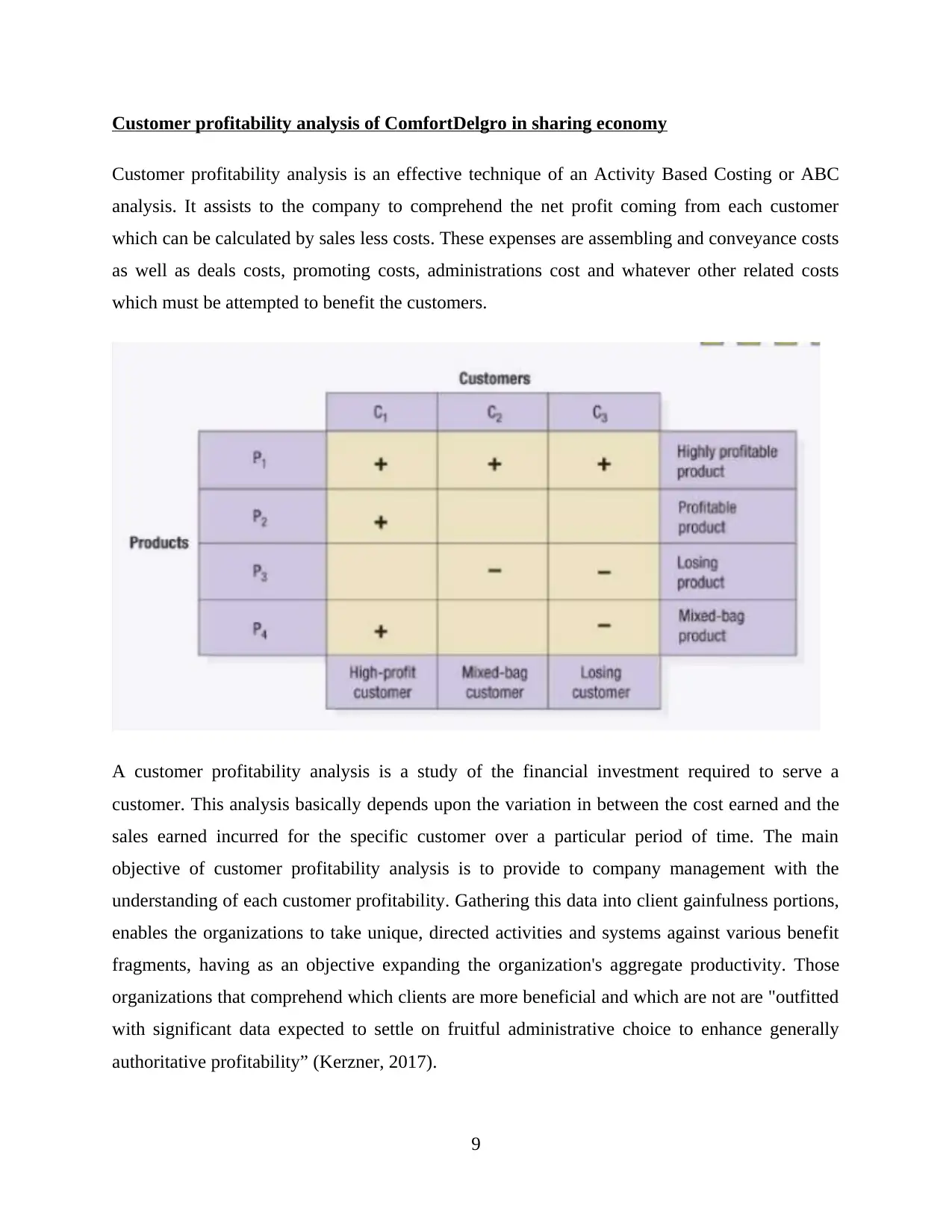
Customer profitability analysis of ComfortDelgro in sharing economy
Customer profitability analysis is an effective technique of an Activity Based Costing or ABC
analysis. It assists to the company to comprehend the net profit coming from each customer
which can be calculated by sales less costs. These expenses are assembling and conveyance costs
as well as deals costs, promoting costs, administrations cost and whatever other related costs
which must be attempted to benefit the customers.
A customer profitability analysis is a study of the financial investment required to serve a
customer. This analysis basically depends upon the variation in between the cost earned and the
sales earned incurred for the specific customer over a particular period of time. The main
objective of customer profitability analysis is to provide to company management with the
understanding of each customer profitability. Gathering this data into client gainfulness portions,
enables the organizations to take unique, directed activities and systems against various benefit
fragments, having as an objective expanding the organization's aggregate productivity. Those
organizations that comprehend which clients are more beneficial and which are not are "outfitted
with significant data expected to settle on fruitful administrative choice to enhance generally
authoritative profitability” (Kerzner, 2017).
9
Customer profitability analysis is an effective technique of an Activity Based Costing or ABC
analysis. It assists to the company to comprehend the net profit coming from each customer
which can be calculated by sales less costs. These expenses are assembling and conveyance costs
as well as deals costs, promoting costs, administrations cost and whatever other related costs
which must be attempted to benefit the customers.
A customer profitability analysis is a study of the financial investment required to serve a
customer. This analysis basically depends upon the variation in between the cost earned and the
sales earned incurred for the specific customer over a particular period of time. The main
objective of customer profitability analysis is to provide to company management with the
understanding of each customer profitability. Gathering this data into client gainfulness portions,
enables the organizations to take unique, directed activities and systems against various benefit
fragments, having as an objective expanding the organization's aggregate productivity. Those
organizations that comprehend which clients are more beneficial and which are not are "outfitted
with significant data expected to settle on fruitful administrative choice to enhance generally
authoritative profitability” (Kerzner, 2017).
9
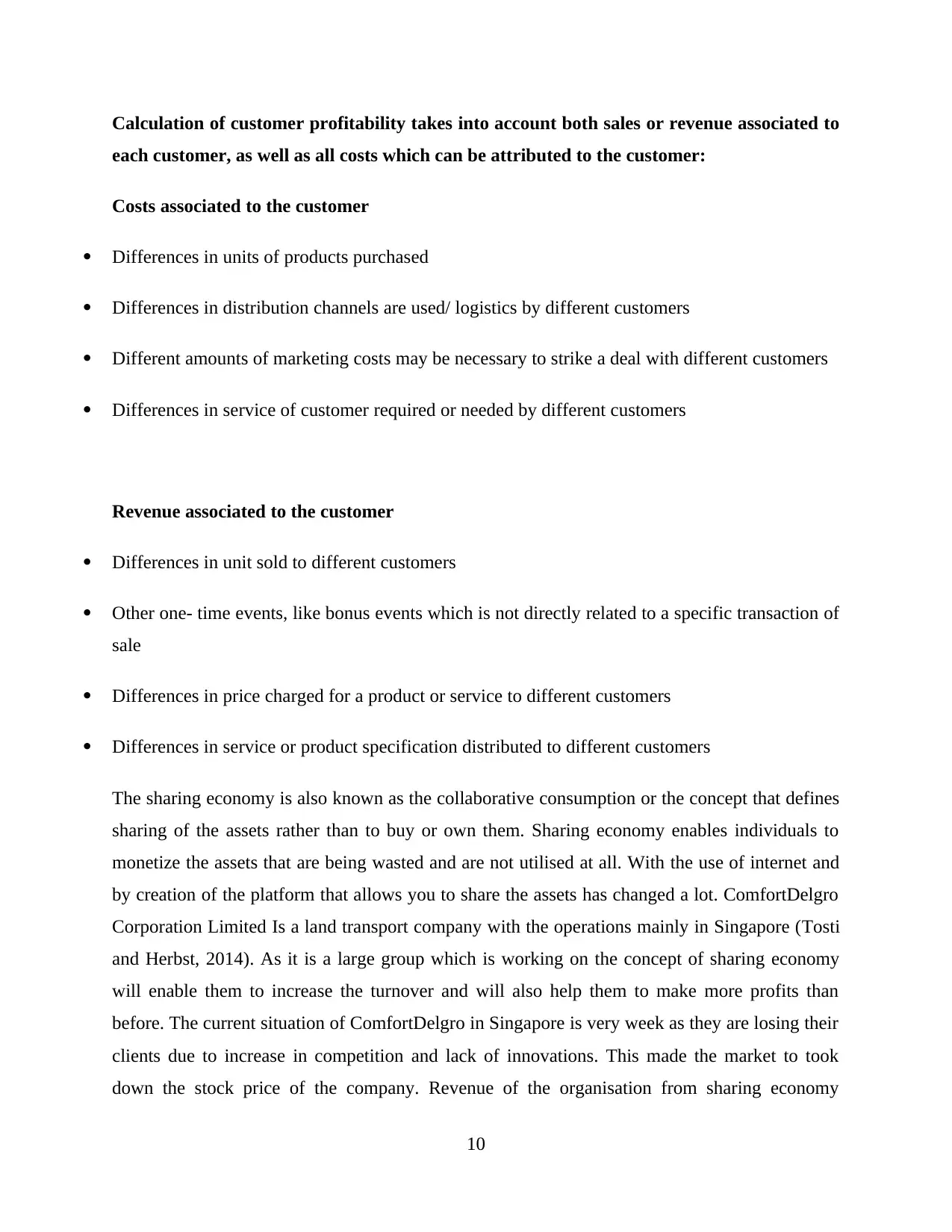
Calculation of customer profitability takes into account both sales or revenue associated to
each customer, as well as all costs which can be attributed to the customer:
Costs associated to the customer
Differences in units of products purchased
Differences in distribution channels are used/ logistics by different customers
Different amounts of marketing costs may be necessary to strike a deal with different customers
Differences in service of customer required or needed by different customers
Revenue associated to the customer
Differences in unit sold to different customers
Other one- time events, like bonus events which is not directly related to a specific transaction of
sale
Differences in price charged for a product or service to different customers
Differences in service or product specification distributed to different customers
The sharing economy is also known as the collaborative consumption or the concept that defines
sharing of the assets rather than to buy or own them. Sharing economy enables individuals to
monetize the assets that are being wasted and are not utilised at all. With the use of internet and
by creation of the platform that allows you to share the assets has changed a lot. ComfortDelgro
Corporation Limited Is a land transport company with the operations mainly in Singapore (Tosti
and Herbst, 2014). As it is a large group which is working on the concept of sharing economy
will enable them to increase the turnover and will also help them to make more profits than
before. The current situation of ComfortDelgro in Singapore is very week as they are losing their
clients due to increase in competition and lack of innovations. This made the market to took
down the stock price of the company. Revenue of the organisation from sharing economy
10
each customer, as well as all costs which can be attributed to the customer:
Costs associated to the customer
Differences in units of products purchased
Differences in distribution channels are used/ logistics by different customers
Different amounts of marketing costs may be necessary to strike a deal with different customers
Differences in service of customer required or needed by different customers
Revenue associated to the customer
Differences in unit sold to different customers
Other one- time events, like bonus events which is not directly related to a specific transaction of
sale
Differences in price charged for a product or service to different customers
Differences in service or product specification distributed to different customers
The sharing economy is also known as the collaborative consumption or the concept that defines
sharing of the assets rather than to buy or own them. Sharing economy enables individuals to
monetize the assets that are being wasted and are not utilised at all. With the use of internet and
by creation of the platform that allows you to share the assets has changed a lot. ComfortDelgro
Corporation Limited Is a land transport company with the operations mainly in Singapore (Tosti
and Herbst, 2014). As it is a large group which is working on the concept of sharing economy
will enable them to increase the turnover and will also help them to make more profits than
before. The current situation of ComfortDelgro in Singapore is very week as they are losing their
clients due to increase in competition and lack of innovations. This made the market to took
down the stock price of the company. Revenue of the organisation from sharing economy
10
Paraphrase This Document
Need a fresh take? Get an instant paraphrase of this document with our AI Paraphraser
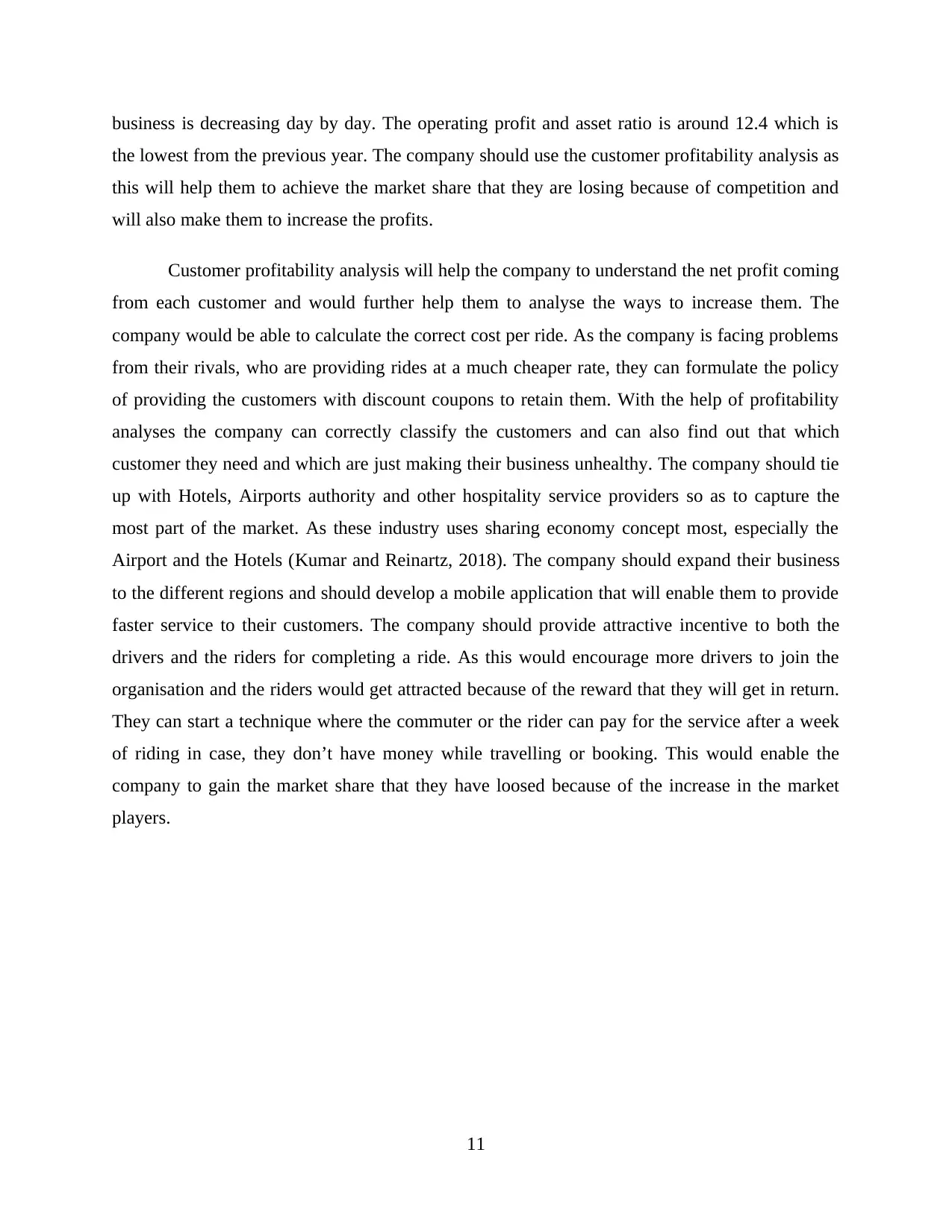
business is decreasing day by day. The operating profit and asset ratio is around 12.4 which is
the lowest from the previous year. The company should use the customer profitability analysis as
this will help them to achieve the market share that they are losing because of competition and
will also make them to increase the profits.
Customer profitability analysis will help the company to understand the net profit coming
from each customer and would further help them to analyse the ways to increase them. The
company would be able to calculate the correct cost per ride. As the company is facing problems
from their rivals, who are providing rides at a much cheaper rate, they can formulate the policy
of providing the customers with discount coupons to retain them. With the help of profitability
analyses the company can correctly classify the customers and can also find out that which
customer they need and which are just making their business unhealthy. The company should tie
up with Hotels, Airports authority and other hospitality service providers so as to capture the
most part of the market. As these industry uses sharing economy concept most, especially the
Airport and the Hotels (Kumar and Reinartz, 2018). The company should expand their business
to the different regions and should develop a mobile application that will enable them to provide
faster service to their customers. The company should provide attractive incentive to both the
drivers and the riders for completing a ride. As this would encourage more drivers to join the
organisation and the riders would get attracted because of the reward that they will get in return.
They can start a technique where the commuter or the rider can pay for the service after a week
of riding in case, they don’t have money while travelling or booking. This would enable the
company to gain the market share that they have loosed because of the increase in the market
players.
11
the lowest from the previous year. The company should use the customer profitability analysis as
this will help them to achieve the market share that they are losing because of competition and
will also make them to increase the profits.
Customer profitability analysis will help the company to understand the net profit coming
from each customer and would further help them to analyse the ways to increase them. The
company would be able to calculate the correct cost per ride. As the company is facing problems
from their rivals, who are providing rides at a much cheaper rate, they can formulate the policy
of providing the customers with discount coupons to retain them. With the help of profitability
analyses the company can correctly classify the customers and can also find out that which
customer they need and which are just making their business unhealthy. The company should tie
up with Hotels, Airports authority and other hospitality service providers so as to capture the
most part of the market. As these industry uses sharing economy concept most, especially the
Airport and the Hotels (Kumar and Reinartz, 2018). The company should expand their business
to the different regions and should develop a mobile application that will enable them to provide
faster service to their customers. The company should provide attractive incentive to both the
drivers and the riders for completing a ride. As this would encourage more drivers to join the
organisation and the riders would get attracted because of the reward that they will get in return.
They can start a technique where the commuter or the rider can pay for the service after a week
of riding in case, they don’t have money while travelling or booking. This would enable the
company to gain the market share that they have loosed because of the increase in the market
players.
11
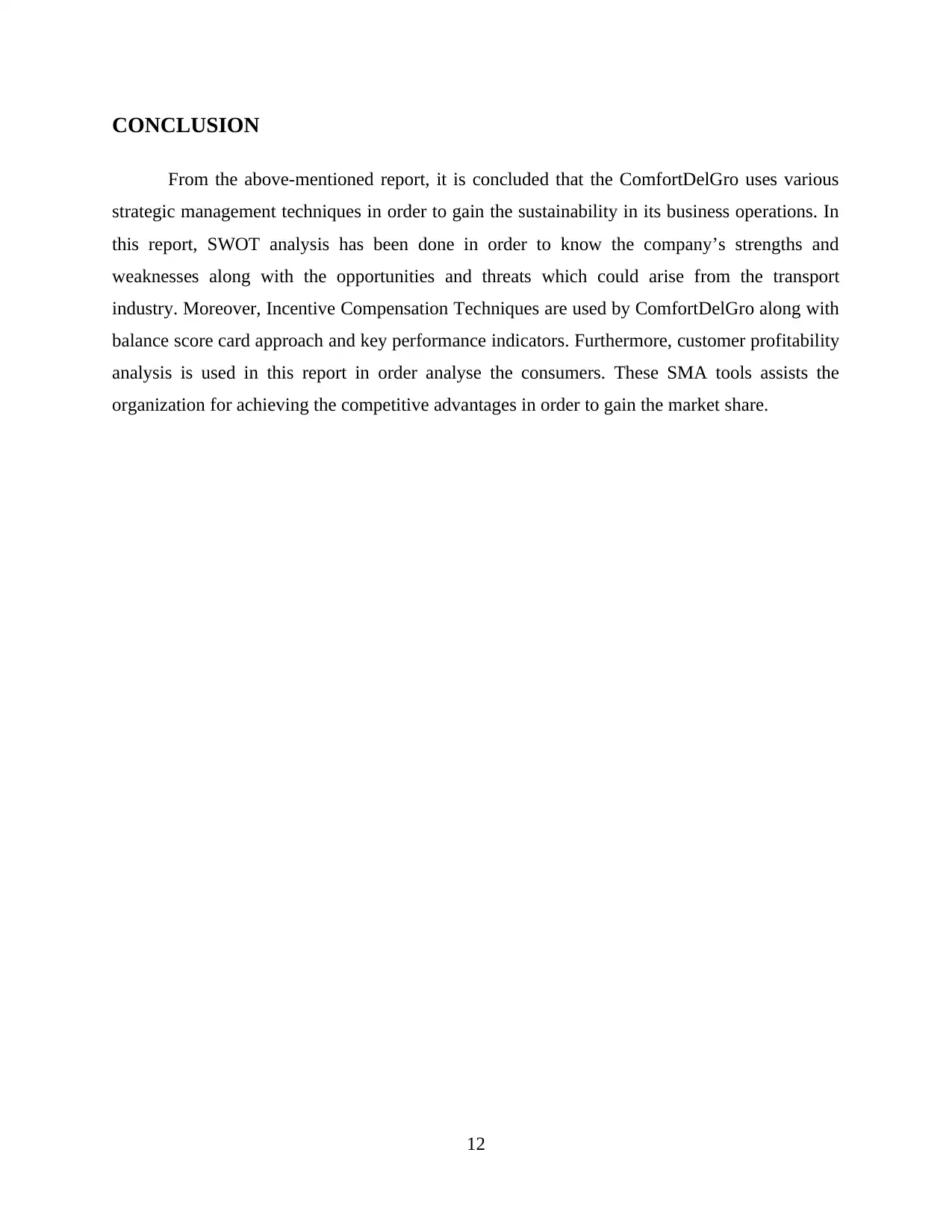
CONCLUSION
From the above-mentioned report, it is concluded that the ComfortDelGro uses various
strategic management techniques in order to gain the sustainability in its business operations. In
this report, SWOT analysis has been done in order to know the company’s strengths and
weaknesses along with the opportunities and threats which could arise from the transport
industry. Moreover, Incentive Compensation Techniques are used by ComfortDelGro along with
balance score card approach and key performance indicators. Furthermore, customer profitability
analysis is used in this report in order analyse the consumers. These SMA tools assists the
organization for achieving the competitive advantages in order to gain the market share.
12
From the above-mentioned report, it is concluded that the ComfortDelGro uses various
strategic management techniques in order to gain the sustainability in its business operations. In
this report, SWOT analysis has been done in order to know the company’s strengths and
weaknesses along with the opportunities and threats which could arise from the transport
industry. Moreover, Incentive Compensation Techniques are used by ComfortDelGro along with
balance score card approach and key performance indicators. Furthermore, customer profitability
analysis is used in this report in order analyse the consumers. These SMA tools assists the
organization for achieving the competitive advantages in order to gain the market share.
12
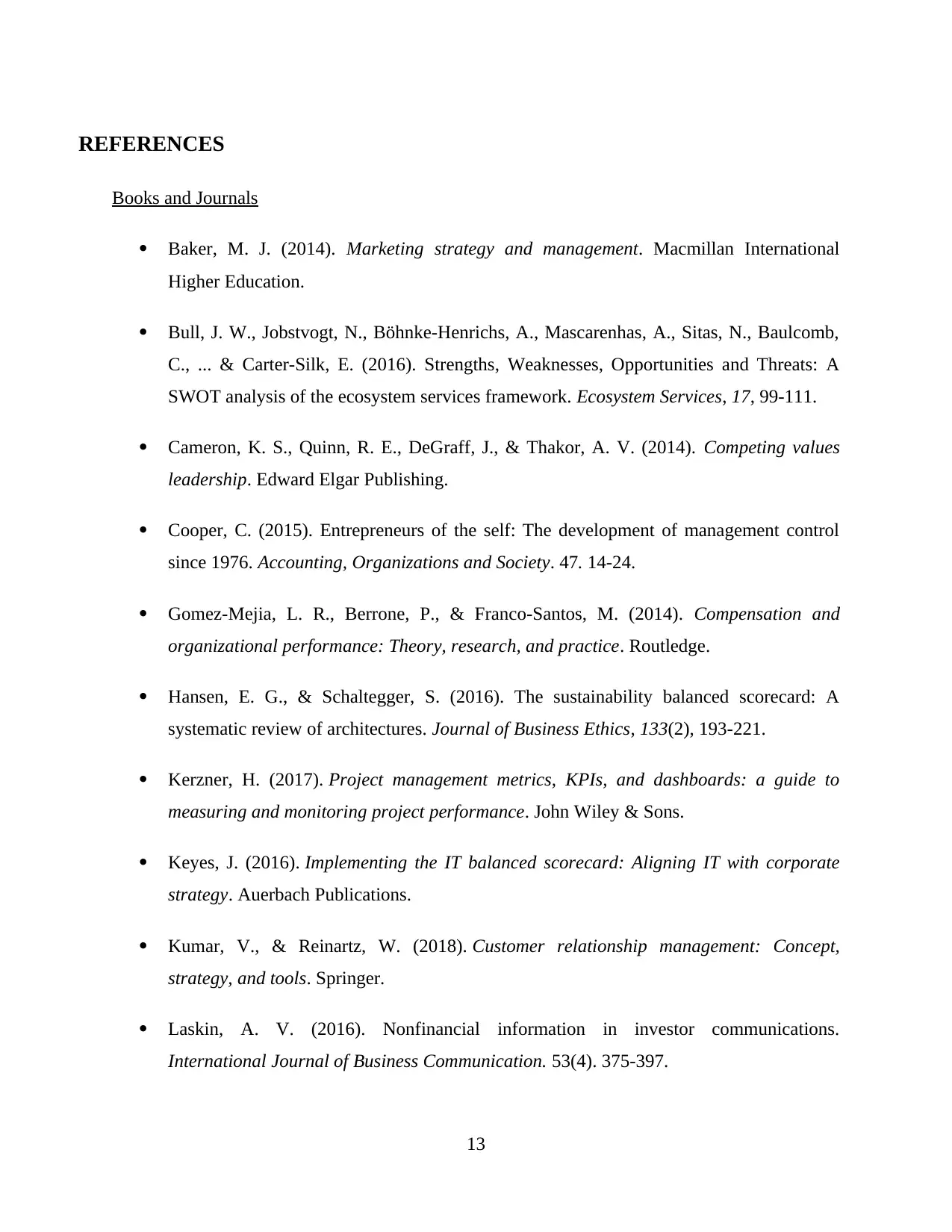
REFERENCES
Books and Journals
Baker, M. J. (2014). Marketing strategy and management. Macmillan International
Higher Education.
Bull, J. W., Jobstvogt, N., Böhnke-Henrichs, A., Mascarenhas, A., Sitas, N., Baulcomb,
C., ... & Carter-Silk, E. (2016). Strengths, Weaknesses, Opportunities and Threats: A
SWOT analysis of the ecosystem services framework. Ecosystem Services, 17, 99-111.
Cameron, K. S., Quinn, R. E., DeGraff, J., & Thakor, A. V. (2014). Competing values
leadership. Edward Elgar Publishing.
Cooper, C. (2015). Entrepreneurs of the self: The development of management control
since 1976. Accounting, Organizations and Society. 47. 14-24.
Gomez-Mejia, L. R., Berrone, P., & Franco-Santos, M. (2014). Compensation and
organizational performance: Theory, research, and practice. Routledge.
Hansen, E. G., & Schaltegger, S. (2016). The sustainability balanced scorecard: A
systematic review of architectures. Journal of Business Ethics, 133(2), 193-221.
Kerzner, H. (2017). Project management metrics, KPIs, and dashboards: a guide to
measuring and monitoring project performance. John Wiley & Sons.
Keyes, J. (2016). Implementing the IT balanced scorecard: Aligning IT with corporate
strategy. Auerbach Publications.
Kumar, V., & Reinartz, W. (2018). Customer relationship management: Concept,
strategy, and tools. Springer.
Laskin, A. V. (2016). Nonfinancial information in investor communications.
International Journal of Business Communication. 53(4). 375-397.
13
Books and Journals
Baker, M. J. (2014). Marketing strategy and management. Macmillan International
Higher Education.
Bull, J. W., Jobstvogt, N., Böhnke-Henrichs, A., Mascarenhas, A., Sitas, N., Baulcomb,
C., ... & Carter-Silk, E. (2016). Strengths, Weaknesses, Opportunities and Threats: A
SWOT analysis of the ecosystem services framework. Ecosystem Services, 17, 99-111.
Cameron, K. S., Quinn, R. E., DeGraff, J., & Thakor, A. V. (2014). Competing values
leadership. Edward Elgar Publishing.
Cooper, C. (2015). Entrepreneurs of the self: The development of management control
since 1976. Accounting, Organizations and Society. 47. 14-24.
Gomez-Mejia, L. R., Berrone, P., & Franco-Santos, M. (2014). Compensation and
organizational performance: Theory, research, and practice. Routledge.
Hansen, E. G., & Schaltegger, S. (2016). The sustainability balanced scorecard: A
systematic review of architectures. Journal of Business Ethics, 133(2), 193-221.
Kerzner, H. (2017). Project management metrics, KPIs, and dashboards: a guide to
measuring and monitoring project performance. John Wiley & Sons.
Keyes, J. (2016). Implementing the IT balanced scorecard: Aligning IT with corporate
strategy. Auerbach Publications.
Kumar, V., & Reinartz, W. (2018). Customer relationship management: Concept,
strategy, and tools. Springer.
Laskin, A. V. (2016). Nonfinancial information in investor communications.
International Journal of Business Communication. 53(4). 375-397.
13
Secure Best Marks with AI Grader
Need help grading? Try our AI Grader for instant feedback on your assignments.
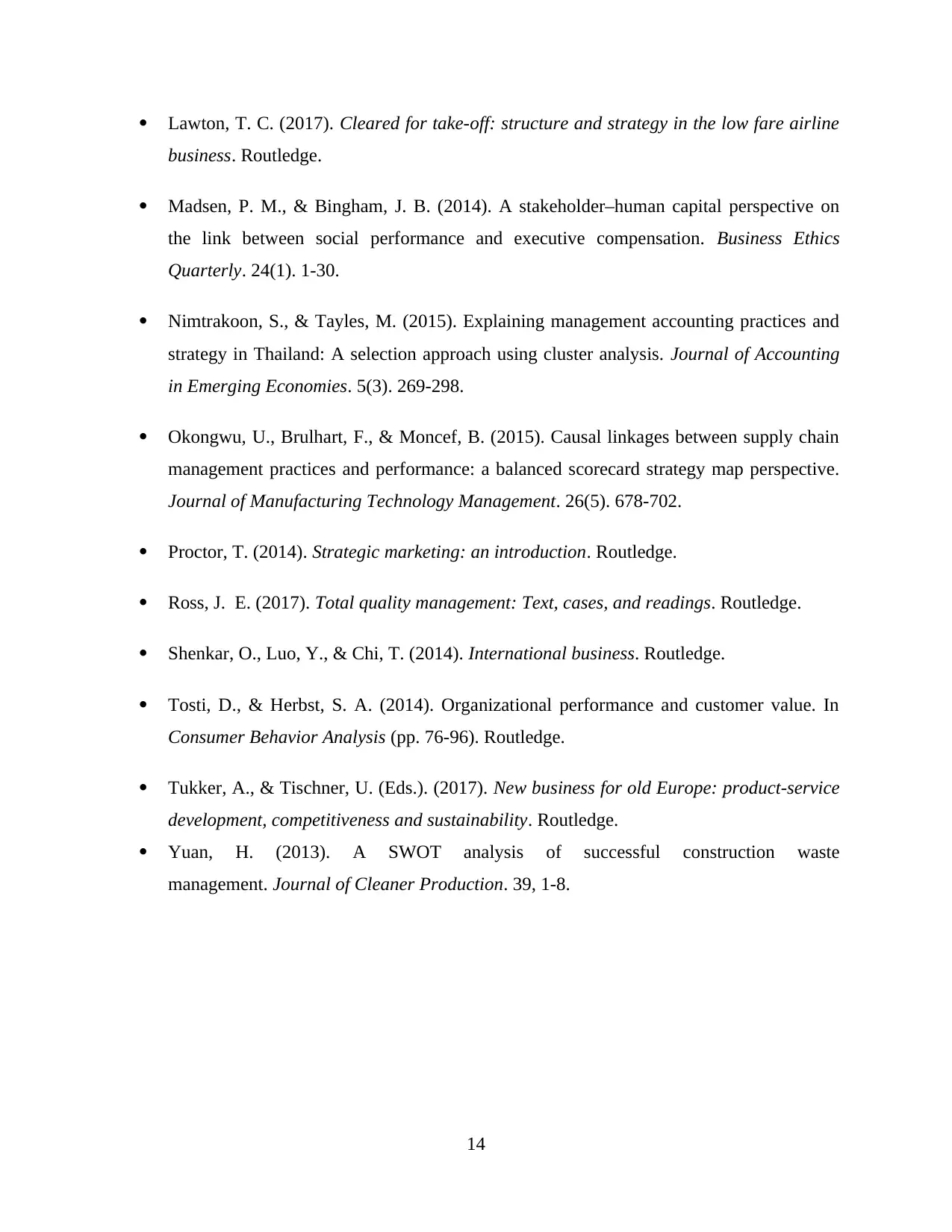
Lawton, T. C. (2017). Cleared for take-off: structure and strategy in the low fare airline
business. Routledge.
Madsen, P. M., & Bingham, J. B. (2014). A stakeholder–human capital perspective on
the link between social performance and executive compensation. Business Ethics
Quarterly. 24(1). 1-30.
Nimtrakoon, S., & Tayles, M. (2015). Explaining management accounting practices and
strategy in Thailand: A selection approach using cluster analysis. Journal of Accounting
in Emerging Economies. 5(3). 269-298.
Okongwu, U., Brulhart, F., & Moncef, B. (2015). Causal linkages between supply chain
management practices and performance: a balanced scorecard strategy map perspective.
Journal of Manufacturing Technology Management. 26(5). 678-702.
Proctor, T. (2014). Strategic marketing: an introduction. Routledge.
Ross, J. E. (2017). Total quality management: Text, cases, and readings. Routledge.
Shenkar, O., Luo, Y., & Chi, T. (2014). International business. Routledge.
Tosti, D., & Herbst, S. A. (2014). Organizational performance and customer value. In
Consumer Behavior Analysis (pp. 76-96). Routledge.
Tukker, A., & Tischner, U. (Eds.). (2017). New business for old Europe: product-service
development, competitiveness and sustainability. Routledge.
Yuan, H. (2013). A SWOT analysis of successful construction waste
management. Journal of Cleaner Production. 39, 1-8.
14
business. Routledge.
Madsen, P. M., & Bingham, J. B. (2014). A stakeholder–human capital perspective on
the link between social performance and executive compensation. Business Ethics
Quarterly. 24(1). 1-30.
Nimtrakoon, S., & Tayles, M. (2015). Explaining management accounting practices and
strategy in Thailand: A selection approach using cluster analysis. Journal of Accounting
in Emerging Economies. 5(3). 269-298.
Okongwu, U., Brulhart, F., & Moncef, B. (2015). Causal linkages between supply chain
management practices and performance: a balanced scorecard strategy map perspective.
Journal of Manufacturing Technology Management. 26(5). 678-702.
Proctor, T. (2014). Strategic marketing: an introduction. Routledge.
Ross, J. E. (2017). Total quality management: Text, cases, and readings. Routledge.
Shenkar, O., Luo, Y., & Chi, T. (2014). International business. Routledge.
Tosti, D., & Herbst, S. A. (2014). Organizational performance and customer value. In
Consumer Behavior Analysis (pp. 76-96). Routledge.
Tukker, A., & Tischner, U. (Eds.). (2017). New business for old Europe: product-service
development, competitiveness and sustainability. Routledge.
Yuan, H. (2013). A SWOT analysis of successful construction waste
management. Journal of Cleaner Production. 39, 1-8.
14

15
1 out of 18
Related Documents
Your All-in-One AI-Powered Toolkit for Academic Success.
+13062052269
info@desklib.com
Available 24*7 on WhatsApp / Email
![[object Object]](/_next/static/media/star-bottom.7253800d.svg)
Unlock your academic potential
© 2024 | Zucol Services PVT LTD | All rights reserved.





